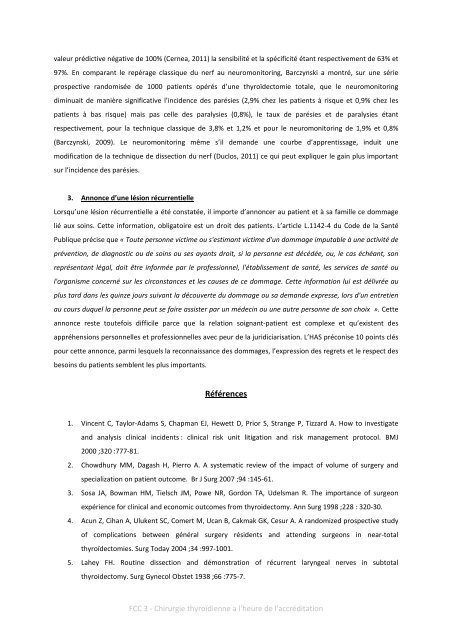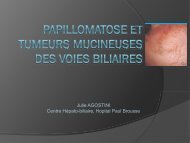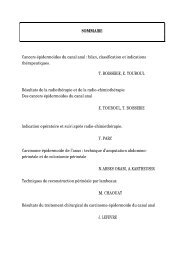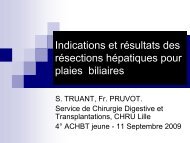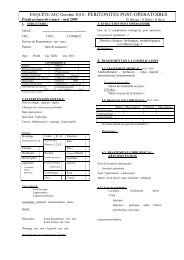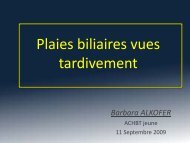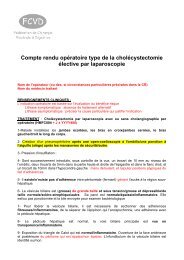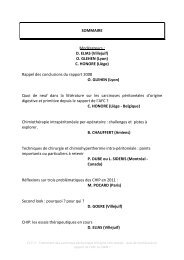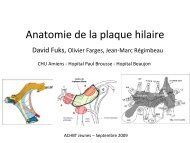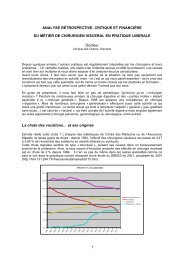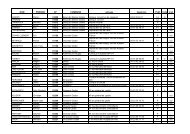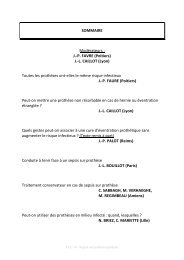FCC3 mise en page - Fédération française de chirurgie viscérale et ...
FCC3 mise en page - Fédération française de chirurgie viscérale et ...
FCC3 mise en page - Fédération française de chirurgie viscérale et ...
Create successful ePaper yourself
Turn your PDF publications into a flip-book with our unique Google optimized e-Paper software.
valeur prédictive négative <strong>de</strong> 100% (Cernea, 2011) la s<strong>en</strong>sibilité <strong>et</strong> la spécificité étant respectivem<strong>en</strong>t <strong>de</strong> 63% <strong>et</strong><br />
97%. En comparant le repérage classique du nerf au neuromonitoring, Barczynski a montré, sur une série<br />
prospective randomisée <strong>de</strong> 1000 pati<strong>en</strong>ts opérés d’une thyroï<strong>de</strong>ctomie totale, que le neuromonitoring<br />
diminuait <strong>de</strong> manière significative l’incid<strong>en</strong>ce <strong>de</strong>s parésies (2,9% chez les pati<strong>en</strong>ts à risque <strong>et</strong> 0,9% chez les<br />
pati<strong>en</strong>ts à bas risque) mais pas celle <strong>de</strong>s paralysies (0,8%), le taux <strong>de</strong> parésies <strong>et</strong> <strong>de</strong> paralysies étant<br />
respectivem<strong>en</strong>t, pour la technique classique <strong>de</strong> 3,8% <strong>et</strong> 1,2% <strong>et</strong> pour le neuromonitoring <strong>de</strong> 1,9% <strong>et</strong> 0,8%<br />
(Barczynski, 2009). Le neuromonitoring même s’il <strong>de</strong>man<strong>de</strong> une courbe d’appr<strong>en</strong>tissage, induit une<br />
modification <strong>de</strong> la technique <strong>de</strong> dissection du nerf (Duclos, 2011) ce qui peut expliquer le gain plus important<br />
sur l’incid<strong>en</strong>ce <strong>de</strong>s parésies.<br />
3. Annonce d’une lésion récurr<strong>en</strong>tielle<br />
Lorsqu’une lésion récurr<strong>en</strong>tielle a été constatée, il importe d’annoncer au pati<strong>en</strong>t <strong>et</strong> à sa famille ce dommage<br />
lié aux soins. C<strong>et</strong>te information, obligatoire est un droit <strong>de</strong>s pati<strong>en</strong>ts. L’article L.1142-4 du Co<strong>de</strong> <strong>de</strong> la Santé<br />
Publique précise que « Toute personne victime ou s'estimant victime d'un dommage imputable à une activité <strong>de</strong><br />
prév<strong>en</strong>tion, <strong>de</strong> diagnostic ou <strong>de</strong> soins ou ses ayants droit, si la personne est décédée, ou, le cas échéant, son<br />
représ<strong>en</strong>tant légal, doit être informée par le professionnel, l'établissem<strong>en</strong>t <strong>de</strong> santé, les services <strong>de</strong> santé ou<br />
l'organisme concerné sur les circonstances <strong>et</strong> les causes <strong>de</strong> ce dommage. C<strong>et</strong>te information lui est délivrée au<br />
plus tard dans les quinze jours suivant la découverte du dommage ou sa <strong>de</strong>man<strong>de</strong> expresse, lors d'un <strong>en</strong>tr<strong>et</strong>i<strong>en</strong><br />
au cours duquel la personne peut se faire assister par un mé<strong>de</strong>cin ou une autre personne <strong>de</strong> son choix ». C<strong>et</strong>te<br />
annonce reste toutefois difficile parce que la relation soignant-pati<strong>en</strong>t est complexe <strong>et</strong> qu’exist<strong>en</strong>t <strong>de</strong>s<br />
appréh<strong>en</strong>sions personnelles <strong>et</strong> professionnelles avec peur <strong>de</strong> la juridiciarisation. L’HAS préconise 10 points clés<br />
pour c<strong>et</strong>te annonce, parmi lesquels la reconnaissance <strong>de</strong>s dommages, l’expression <strong>de</strong>s regr<strong>et</strong>s <strong>et</strong> le respect <strong>de</strong>s<br />
besoins du pati<strong>en</strong>ts sembl<strong>en</strong>t les plus importants.<br />
Référ<strong>en</strong>ces<br />
1. Vinc<strong>en</strong>t C, Taylor-Adams S, Chapman EJ, Hew<strong>et</strong>t D, Prior S, Strange P, Tizzard A. How to investigate<br />
and analysis clinical incid<strong>en</strong>ts : clinical risk unit litigation and risk managem<strong>en</strong>t protocol. BMJ<br />
2000 ;320 :777-81.<br />
2. Chowdhury MM, Dagash H, Pierro A. A systematic review of the impact of volume of surgery and<br />
specialization on pati<strong>en</strong>t outcome. Br J Surg 2007 ;94 :145-61.<br />
3. Sosa JA, Bowman HM, Tielsch JM, Powe NR, Gordon TA, U<strong>de</strong>lsman R. The importance of surgeon<br />
expéri<strong>en</strong>ce for clinical and economic outcomes from thyroi<strong>de</strong>ctomy. Ann Surg 1998 ;228 : 320-30.<br />
4. Acun Z, Cihan A, Uluk<strong>en</strong>t SC, Comert M, Ucan B, Cakmak GK, Cesur A. A randomized prospective study<br />
of complications b<strong>et</strong>we<strong>en</strong> général surgery résid<strong>en</strong>ts and att<strong>en</strong>ding surgeons in near-total<br />
thyroï<strong>de</strong>ctomies. Surg Today 2004 ;34 :997-1001.<br />
5. Lahey FH. Routine dissection and démonstration of récurr<strong>en</strong>t laryngeal nerves in subtotal<br />
thyroi<strong>de</strong>ctomy. Surg Gynecol Obst<strong>et</strong> 1938 ;66 :775-7.<br />
FCC 3 - Chirurgie thyroïdi<strong>en</strong>ne a l'heure <strong>de</strong> l'accréditation


